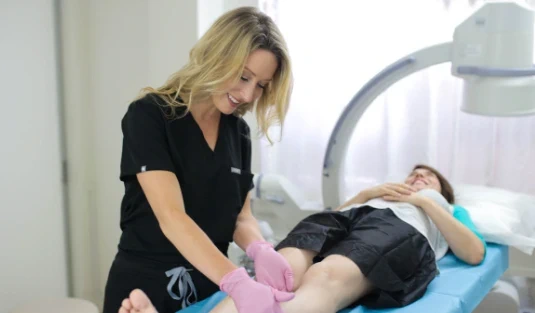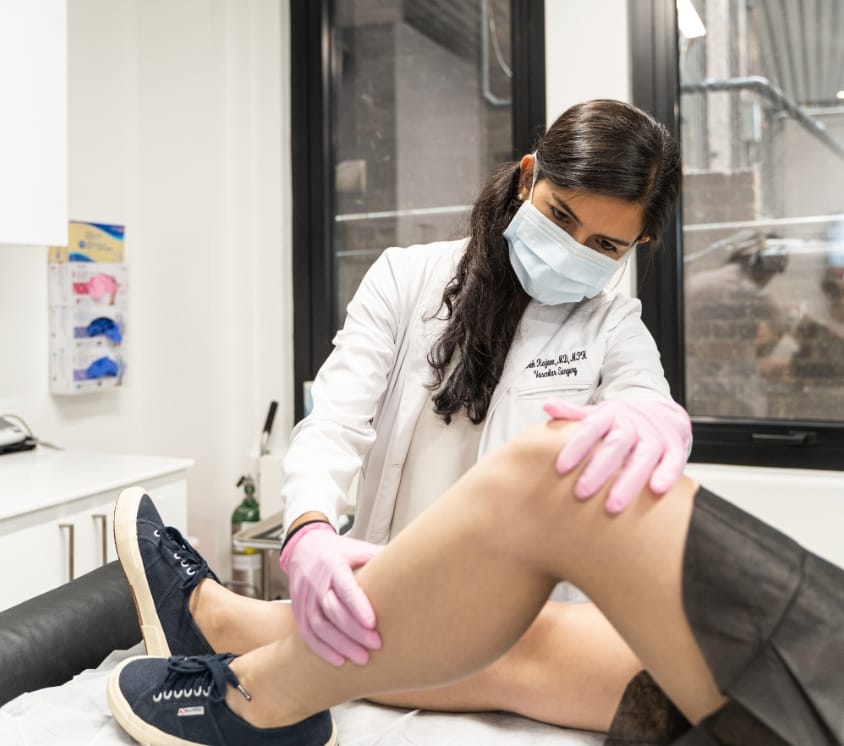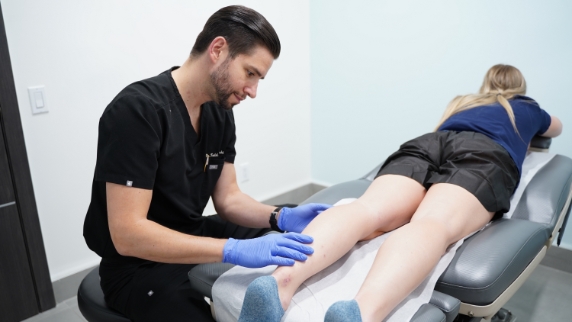There are symptoms concerning vein disorders that affect the legs that should never be ignored. So, if you feel throbbing pain that is accompanied by fatigue, heaviness and swelling, visit the best vein treatment center near you. If you ignore these symptoms, you might end up with the worst case of a venous reflux disease. Also called venous insufficiency or venous disease, this condition can incapacitate you to an extent that you can no longer work. Thus, early signs of venous reflux should never be ignored. If there is an ongoing disease affecting your leg veins, ensure that you go to the most reputable vein treatment clinic as soon as possible. Meanwhile, here are 12 vein issues you might be suffering from:
1. Telangiectasia
This condition refers to a convergence of dilated intradermal venules of less than one millimeter in diameter. Also known as spider veins, sunburst veins or thread veins, telangiectasias are often red, blue, purple or pink. They take the shape of a spider web or a tree branch and can affect a large area of your leg. Commonly affecting more women (about 25%) than men (about 15% have spider veins), thread veins are categorized as Type I veins in the classification of veins.
While they can go away on their own, some spider veins are serious and can be a sign that you have a problem other than venous reflux. Thus, going to a spider vein center is much recommended. You will know whether your condition is spider veins or reticular veins. Next, you will be treated using the right technique. Telangiectasias tend to respond to sclerotherapy and laser therapy. Concerning sclerotherapy, your favorite vein treatment centre will either use traditional or dynamic foam sclerotherapy.
The latter is more advanced than the former, although both methods involve like two or more sessions where a particular substance that damages your painful veins is injected. Concerning laser therapy, doctors use topical lasers to eradicate telangiestasias. A vein treatment clinic that is worth visiting should have different kinds of lasers to treat spider veins with. That’s because each laser is unique such that some are designed to deliver their healing beam deeper and others are for treating superficial veins.
2. Reticular Vein
This is yet another problem that can affect your leg veins. Reticular veins looks so much like spider veins except that they have deeper bluish tinge. They are dilated intradermal veins that are often one to three millimeters in diameter. While spider veins form a perfect spider vein or twig pattern, reticular veins are twisty. Also called blue veins or intradermal varices, reticular veins are classed as Type III veins in the classification of veins. Sometimes reticular veins cause telangiectasias and in such a case they are known as feeder veins. And when blue veins are diagnosed, they should be cured before eliminating spider veins to stop early reappearance. A good vein treatment center will provide treatment options such as ultrasound guided foam sclerotherapy and dynamic foam sclerotherapy.
3. Varicose veins
This is probably the most prevalent condition affecting both genders in the U.S and a vein problem that is commonly treated by almost every vein treatment clinic. Varicose veins, also varicosities, varices or varix, entail subcutaneous dilated veins that are bigger than 3 millimeters in diameter. They often take an upright posture. Varices can occur in your medial, anterior, lateral or posterior thigh. Additionally, varicose veins can affect your anterior, medial, lateral and posterior leg. Some people’s lateral and medial ankles develop varicosities. When some ladies are pregnant, they get varices in their external genital area.
Chronic phlebitis happens due serious varicose veins and can cause pain, itch, burning, and cramping that are not relieved by wearing compression stockings. Varices are usually puffed, large and twisted like a rope. They cannot be hidden from prying eyes due to their size and shape. Varicose veins happen due to pooling of blood in the leg vein—venous insufficiency. This is when the valves located in the veins are unable to close completely when deoxygenated blood passes through them. This causes some of the blood to flow backward and this leakage causes pooling inside the vein.
The vein will then swell due to the excessive pressure exerted on it and will cause you to feel heaviness in legs. If you think you have varicosities, visit a good vein treatment center in your area now. Once you get examined by your doctor, your varices will be treated in the best way possible. If they are small to medium sized, your varicose veins will be treated with sclerotherapy. Prior to treating larger veins with surgery, the doctor at your favorite spider veins center will use endovenous laser Ablation therapy as it is minimally invasive? While some people are able to live with unproblematic varicosities, this is not recommended. Instead, one should locate a vein treatment clinic and go there to get a diagnosis and treatment.
4. Superficial Thrombophlebitis
This is yet another problem that can affect your leg veins. You might go to a vein treatment center thinking that you have a different vein disease only to be told that you have superficial thrombophlebitis. But what is this about? This is a situation where superficial veins clot (thrombose) and trigger inflammation, redness (erythema) and palpable warmth along the vein. But, as soon as your spider vein center treats your phlebitis in anti-inflammatory medicines, the doctor should then remove your vein via a microphlebectomy approach. By so doing, he or she can prevent hyperpigmentation and trophic changes of the overlying skin. Microphlebectomy is designed for large varices that are accompanied by thrombophlebitis. But this is only if they have persisted after being cured with traditional treatment approaches like steroidal anti-inflammatory drugs. Hence, visit a great vein treatment center to learn if microphlebectomy is all right for you.
5. Corona phlebectasia
This refers to small intradermal veins that develop on the inner or outer side of your ankle or foot. Normally shaped like a fan, tiny intradermal veins indicate that you have an advanced venous reflux disease. Further, these fan-shaped veins tend to crown your ankle and usually emanate from the saphenofemoral junction where venous blood refluxes into the great saphenous vein. Corona phlebectatica should be diagnosed by the leading vein treatment clinic prior to being treated. If you get a positive diagnosis, your doctor will treat you via EVLT, ClariVein Procedure or Venefit Procedure. The abnormal veins around your ankles can be eradicated via sclerotherapy or topical laser therapy. However, your physician at your favorite vein treatment center will not over-inject the area to avoid hyperpigmentatioin of the ankle.
6. Edema
This refers to the tissue fluid in your skin and subcutaneous. Just like spider veins and varicose veins, edema is associated with the venous disease. It is important to see your doctor at the nearest vein treatment clinic, therefore, because your edema could indicate another problem. Maybe you have congestive heart failure, kidney failure or another systematic ailment. Once you go to a vein treatment center in your area, you will rule out these serious diseases. And, if you are found to have them, your healthcare professional will direct you to the right medical expert.
7. Hyper-pigmentation and how a spider vein center can assist you
This refers to the discoloration of the skin in people who suffer from a chronic venous disease and inflammation of varicosities. The affected areas of skin appear purple or bronze-brown. Hyperpigmentation affects your ankles, lower legs and feet. When the case is extensive and serious, hyperpigmentation can happen along with sclerosis, a condition that causes the skin to thicken. It can also be accompanied by lipodermatosclerosis— subcutaneous fatty tissue. So, it is necessary to have yourself checked at a good vein treatment center if your leg skin is starting to develop discolorations. Diagnosis of this problem involves duplex scanning, which entails a blend of two scans: ultrasound and Doppler scanning.
8. Stasis Dermatitis
It is a condition that is related to chronic venous insufficiency and irritated varicose veins. It consists of skin scales, blisters and oozing and mostly attacks your ankles, legs and thighs. Also referred to as gravitational eczema or venous eczema, stasis dermatitis mostly starts to form where the blood has pooled in a vein. It is often treated with steroid creams. We would advise you to have your legs checked by a doctor who works in a reputable vein treatment clinic. If he or she verifies that you have stasis dermatitis, they will address the root cause.
9. Venous stasis ulcer
This is a wound that develops in your leg or ankle areas and do not heal easily. It is directly related to chronic venous insufficiency. This form of ulceration is known to be extremely painful and stubborn in terms of healing. Several approaches are normally used to treat venous stasis ulcers as they can be very persistent. In order to heal these, you need to pick a vein treatment center that can get rid of them in the best way possible. Skin grafting is sometimes done to heal severe ulcers.
10. Atrophie Blanche
It is a type of hypopigmentation(involving circular whitish skin) that indicates a chronic form of venous reflux. Atrophie Blanche causes skin alterations due to advanced venous disease or after the treatment of venous ulcers. The best way to have these diagnosed is to visit a local vein treatment clinic that has excellent services and doctors.
11. Lipodermatosclerosis
This is a chronic condition that entails inflammation and sclerosis of the skin and requires quick attention from your vein treatment clinic. Lipo refers to the subcutaneous fat while derma refers to the skin. Lipodermatosclerosis involves lower leg scarring where the whole circumference is affected. It entails brown discolorations, fibrous skin, hypopigmentation, hyperpigmentation, cirmcumferential inflammation and contraction of the affected area. It is an extremely difficult and chronic condition to have and is diagnosed the same way as hyperpigmentation.
12. Bleeding due to venous reflux disease
Spontaneous bleeding from a politeal perforator vein is quite common and if you spot it behind your knee, then you should know you have a venous reflux disease. It is important to visit a vein treatment center to know if you have chronic venous hypertension that is putting your varicose veins under excessive pressure and bleeding. Skin that is affected by venous disease tends to be very thin and a small injury can cause it to bleed. If you have noticed this sort of thing, we would recommend calling a spider vein centre about it.
The most common type of vein treatment
Sclerotherapy tends to be the first pick when one has a vein disease. As it is a commonly used treatment method, sclerotherapy is available in almost any vein treatment clinic. This technique entails the use of a sclerosing agent that kills or damages a failed vein. Your doctor can select any of these sclerosing agents: detergent, hyperosmolar or chemical. Hypertonic saline (in the hyperosmolar category) involving 23.4 percent of sodium chloride is widely used in the U.S. It does cause some side effects such as cramping pain and burning on the injection site.
Also, it tends to be ideal for the treatment of spider veins, varicose veins and reticular veins and can be diluted to avoid the aforementioned side effects. But dilution is not necessary when trying to eradicate large varicose veins as the treatment will be ineffective. Our advice is to discuss various sclerosing agents with your doctor at your preferred vein treatment center prior to starting your sclerotherapy sessions.
Other techniques offered by a reputable spider vein center
Besides sclerotherapy, there are other treatment options your doctor can pick for you. They will make their decision based on how serious they find your condition and its kind. When surgery is not necessary, your doctors will use less invasive techniques such as laser-based techniques or catheter-based techniques. If your problem is not very serious, your vein treatment clinic doctor may decide to do micro sclerotherapy, endovenous ablation therapy, or ambulatory phlebectomy. Otherwise, extremely severe cases are treated via endoscopic vein surgery or vein stripping and ligation.
Conclusion
We have listed and discussed 7 conditions that can attack your leg veins. If you have noticed unusual veins in legs that might be causing pain, swelling, or itching, ensure that you visit a vein treatment clinic right away. By so doing, your vein disease will be discovered right on time and treated to give you peace of mind.













